The Spatiotemporal Evolution and Coupling Coordination of LUCC and Landscape Ecological Risk in Ecologically Vulnerable Areas: A Case Study of the Wanzhou–Dazhou–Kaizhou Region
Abstract
1. Introduction
2. Materials and Methods
2.1. Study Area
2.2. Data Sources and Processing
2.3. Methodology
2.3.1. Effects of Spatial Scale
- (1)
- Division of fundamental and evaluative units
- (2)
- Area Information Loss Estimation (AILE) Model
- (3)
- Semivariogram
2.3.2. Intensity Analysis
2.3.3. Comprehensive Index of LUI
2.3.4. LER Assessment
2.3.5. CCD Model
| Landscape Index | Calculation or Assignment | Parameter Meaning |
|---|---|---|
| Landscape Fragmentation () | is the number of patches for landscape type . is the total area of landscape type . | |
| Landscape Separation () | is the total area of all landscapes in the study region. is the total area of landscape type . | |
| Landscape Dominance () | is the proportion of risk units containing landscape type to the total number of risk units, is the ratio of patches of landscape type to the total number of patches, and is the ratio of the area of landscape type to the total landscape area. | |
| Landscape Disturbance () | , , and are the weighting coefficients for , , and , respectively; , , and were assigned values of 0.5, 0.3, and 0.2, with [60]. | |
| Landscape Vulnerability () | Normalization processing | Reference-related research and WDK landscape feature [42,61,62]: WDK’s Unused category (mainly bare soil) was assigned the highest vulnerability score of 6 due to its lack of vegetation cover. Water scored 5, being susceptible to irreversible anthropogenic damage. Crop scored 4, given its peri-urban location and ease of conversion to built-up areas. Grass and Forest, which were less affected by human activities, scored 3 and 2, respectively. Built was given the lowest score of 1, as it is least likely to change due to external disturbances and exhibits high stability. |
| Landscape Loss () | is the landscape loss index, which represents the degree of ecosystem damage when the i-th type of landscape is disturbed [63]. |
3. Results
3.1. Spatial Effect Analysis
3.1.1. Spatial Grain Analysis
3.1.2. Spatial Extent Analysis
3.2. Examination of Land Use Transformations
3.2.1. Analysis of Land Use Changes over Time
- (1)
- Dynamics of Land Use Composition and Interval Levels
- (2)
- Changes in Category Levels
- (3)
- Changes in Transition Levels
3.2.2. Spatial Analysis of Land Use Changes
3.3. Spatiotemporal Changes in LER
3.4. CCD Analysis of LUI and LER
4. Discussion
4.1. LUCC Process at Spatiotemporal Scales
4.2. Comparative Analysis of LER Characteristics
4.3. Interaction Between LUI and LER
- (1)
- After 2000, rapid agricultural development in Qu County converted southwestern hilly areas into cropland. In Kaizhou, cropland development in the middle reaches of the Nanjiang River resulted in a significant reduction in forestland and grassland. These phenomena cause topsoil loss and may affect regional biodiversity and ecosystem integrity through food chain disruptions [69].
- (2)
- The central urban areas of both regions are distributed along the tributaries of the Yangtze and Jialing Rivers. Due to topographical constraints, urban expansion primarily occurred in flat areas near the riverbanks. Over the past two decades, rapid urbanization has reshaped the ecological processes of river corridors, and the expansion of artificial surfaces has fragmented existing ecological networks. These severe landscape disturbances have led to the fragmentation of many forest and grassland patches [70].
4.4. Limitation
5. Conclusions
- (1)
- Over the 40 years, the main land use types in the WDK region were Crop and Forest. The increase in Built within the WDK region was consistently active, with the change intensity expanding 128-fold. Crop was the primary stable source for this expansion. Evident trends of mutual conversion were observed among Crop, Grass, and Water, with Crop serving as the primary source for increases in Forest, Grass, and Water. Notably, Crop remained stable, avoiding conversion to Unused.
- (2)
- LUI and LER spatial distributions exhibited a consistent south-high, north-low pattern. Medium- and low-intensity areas predominantly occupied high-altitude mountainous regions, while high-intensity areas concentrated in Crop and Built. Emerging high-risk areas were mainly distributed in Qu’s urban construction area, western hills, and central Kaizhou. Concurrently, Dazhu and Tongchuan’s central urban expansion stabilized, accompanied by reduced ecological risk. Built-up area expansion evolved from single-center outward growth to multi-nodal network expansion. The optimal landscape pattern for WDK was determined at a 120 m grain size and 2 km extent.
- (3)
- The CCD between LUI and LER predominantly manifested as moderately unbalanced and basically balanced types, characterized by strong coupling–weak coordination states. The proportion of moderately unbalanced areas increased, while that of basically balanced areas decreased. Although some regions experienced improvements in their ecological environment, there was a notable deterioration in the central area of Kaizhou, as well as in the urban sections of Qu and its hilly western portions.
Author Contributions
Funding
Institutional Review Board Statement
Informed Consent Statement
Data Availability Statement
Conflicts of Interest
References
- Peng, S.; Li, S. Scale Relationship between Landscape Pattern and Water Quality in Different Pollution Source Areas: A Case Study of the Fuxian Lake Watershed, China. Ecol. Indic. 2020, 121, 107136. [Google Scholar] [CrossRef]
- Song, X.; Hansen, M.C.; Stehman, S.V.; Potapov, P.V.; Tyukavina, A.; Vermote, E.F.; Townshend, J.R. Global Land Change from 1982 to 2016. Nature 2018, 560, 639–643. [Google Scholar] [CrossRef]
- Long, H.; Liu, Y.; Hou, X.; Li, T.; Li, Y. Effects of Land Use Transitions Due to Rapid Urbanization on Ecosystem Services: Implications for Urban Planning in the New Developing Area of China. Habitat Int. 2014, 44, 536–544. [Google Scholar] [CrossRef]
- Chen, G.; Li, X.; Liu, X.; Chen, Y.; Liang, X.; Leng, J.; Xu, X.; Liao, W.; Qiu, Y.; Wu, Q.; et al. Global Projections of Future Urban Land Expansion under Shared Socioeconomic Pathways. Nat. Commun. 2020, 11, 537. [Google Scholar] [CrossRef] [PubMed]
- Buonincontri, M.P.; Bosso, L.; Smeraldo, S.; Chiusano, M.L.; Pasta, S.; Di Pasquale, G. Shedding Light on the Effects of Climate and Anthropogenic Pressures on the Disappearance of Fagus Sylvatica in the Italian Lowlands: Evidence from Archaeo-Anthracology and Spatial Analyses. Sci. Total Environ. 2023, 877, 162893. [Google Scholar] [CrossRef]
- Song, X.; Chen, F.; Sun, Y.; Ma, J.; Yang, Y.; Shi, G. Effects of Land Utilization Transformation on Ecosystem Services in Urban Agglomeration on the Northern Slope of the Tianshan Mountains, China. Ecol. Indic. 2024, 162, 112046. [Google Scholar] [CrossRef]
- Gao, L.; Tao, F.; Liu, R.-R.; Wang, Z.-L.; Leng, H.-J.; Zhou, T. Multi-Scenario Simulation and Ecological Risk Analysis of Land Use Based on the PLUS Model: A Case Study of Nanjing. Sustain. Cities Soc. 2022, 85, 104055. [Google Scholar] [CrossRef]
- Li, J.; Hu, D.; Wang, Y.; Chu, J.; Yin, H.; Ma, M. Study of Identification and Simulation of Ecological Zoning through Integration of Landscape Ecological Risk and Ecosystem Service Value. Sustain. Cities Soc. 2024, 107, 105442. [Google Scholar] [CrossRef]
- Jin, Y.; Tan, T.; Tang, Q.; Hua, L.; Guo, Z. Land Use Change Characteristics and Ecological Sensitivity Evaluation in the Black Soil Belt in Northeast China. J. Soil Water Conserv. 2023, 37, 341–349. [Google Scholar] [CrossRef]
- Wang, B.; Ding, M.; Li, S.; Liu, L.; Ai, J. Assessment of Landscape Ecological Risk for a Cross-Border Basin: A Case Study of the Koshi River Basin, Central Himalayas. Ecol. Indic. 2020, 117, 106621. [Google Scholar] [CrossRef]
- Zhang, M.; Chen, E.; Zhang, C.; Liu, C.; Li, J. Multi-Scenario Simulation of Land Use Change and Ecosystem Service Value Based on the Markov–FLUS Model in Ezhou City, China. Sustainability 2024, 16, 6237. [Google Scholar] [CrossRef]
- Li, J.; Yu, S.; Liu, L. Determining the Dominant Factors Determining the Variability of Terrestrial Ecosystem Productivity in China during the Last Two Decades. Land Degrad. Dev. 2020, 31, 2131–2145. [Google Scholar] [CrossRef]
- Qiao, W.; Sheng, Y.; Fang, B.; Wang, Y. Land Use Change Information Mining in Highly Urbanized Area Based on Transfer Matrix: A Case Study of Suzhou, Jiangsu Province. Geogr. Res. 2013, 32, 1497–1507. [Google Scholar]
- Zhang, J.; Li, J.; Yin, B.; Gao, Y.; Liu, X. Evaluation of Land Use Change of Jungar Banner Based on Land Use Transfer Matrix. Bull. Soil Water Conserv. 2018, 38, 131–134. [Google Scholar] [CrossRef]
- Aldwaik, S.Z.; Pontius, R.G. Intensity Analysis to Unify Measurements of Size and Stationarity of Land Changes by Interval, Category, and Transition. Landsc. Urban Plan. 2012, 106, 103–114. [Google Scholar] [CrossRef]
- Yang, J.X.; Gong, J.; Gao, J.; Yin, Q. Stationary and Systematic Characteristics of Land Use and Land Cover Change in the National Central Cities of China Using Intensity Analysis: A Case Study of Wuhan City. Resour. Sci. 2019, 41, 701–716. [Google Scholar]
- Zhang, H.; Qin, N.; Wang, J.; Li, M.; Yang, A.; Lu, Q. Spatio Temporal Pattern and Driving Factors of Land Use in Guangxi Coastal Zone. Res. Soil Water Conserv. 2022, 29, 367–374. [Google Scholar] [CrossRef]
- Huang, B.; Huang, J.; Gilmore Pontius, R.; Tu, Z. Comparison of Intensity Analysis and the Land Use Dynamic Degrees to Measure Land Changes Outside versus inside the Coastal Zone of Longhai, China. Ecol. Indic. 2018, 89, 336–347. [Google Scholar] [CrossRef]
- Deng, Z.; Quan, B. Intensity Analysis to Communicate Detailed Detection of Land Use and Land Cover Change in Chang-Zhu-Tan Metropolitan Region, China. Forests 2023, 14, 939. [Google Scholar] [CrossRef]
- Teixeira, Z.; Marques, J.C.; Pontius, R.G. Evidence for Deviations from Uniform Changes in a Portuguese Watershed Illustrated by CORINE Maps: An Intensity Analysis Approach. Ecol. Indic. 2016, 66, 382–390. [Google Scholar] [CrossRef]
- Peng, S.; Quan, B. Characteristics of Urban Expansion and Regional Comparison of the “Mid-Spine Belt of Beautiful China”. China Land Sci. 2024, 38, 109–121. [Google Scholar]
- Zhuang, D.; Liu, J. Study on the Model of Regional Differentiation of Land Use Degree in China. J. Nat. Resour. 1997, 12, 105–111. [Google Scholar]
- Chen, W.; Chi, G.; Li, J. The Spatial Aspect of Ecosystem Services Balance and Its Determinants. Land Use Policy 2020, 90, 104263. [Google Scholar] [CrossRef]
- Hunsaker, C.T.; Graham, R.L.; Suter, G.W.; O’Neill, R.V.; Barnthouse, L.W.; Gardner, R.H. Assessing Ecological Risk on a Regional Scale. Environ. Manag. 1990, 14, 325–332. [Google Scholar] [CrossRef]
- Li, J.; Pu, R.; Gong, H.; Luo, X.; Ye, M.; Feng, B. Evolution Characteristics of Landscape Ecological Risk Patterns in Coastal Zones in Zhejiang Province, China. Sustainability 2017, 9, 584. [Google Scholar] [CrossRef]
- Jin, X.; Jin, Y.; Mao, X. Ecological Risk Assessment of Cities on the Tibetan Plateau Based on Land Use/Land Cover Changes—Case Study of Delingha City. Ecol. Indic. 2019, 101, 185–191. [Google Scholar] [CrossRef]
- Liu, J.; Wang, M.; Yang, L. Assessing Landscape Ecological Risk Induced by Land-Use/Cover Change in a County in China: A GIS- and Landscape-Metric-Based Approach. Sustainability 2020, 12, 9037. [Google Scholar] [CrossRef]
- Li, S.; Tu, B.; Zhang, Z.; Wang, L.; Zhang, Z.; Che, X.; Wang, Z. Exploring New Methods for Assessing Landscape Ecological Risk in Key Basin. J. Clean. Prod. 2024, 461, 142633. [Google Scholar] [CrossRef]
- Yu, H.; Liu, X.; Zhao, T.; Zhang, M.; Nian, L.; Li, X. Landscape Ecological Risk Assessment of Qilian Mountain National Park Based on Landscape Pattern. Ecol. Sci. 2022, 41, 99–107. [Google Scholar] [CrossRef]
- Xu, W.; Wang, J.; Zhang, M.; Li, S. Construction of Landscape Ecological Network Based on Landscape Ecological Risk Assessment in a Large-Scale Opencast Coal Mine Area. J. Clean. Prod. 2021, 286, 125523. [Google Scholar] [CrossRef]
- Bhan, M.; Gingrich, S.; Roux, N.; Le Noë, J.; Kastner, T.; Matej, S.; Schwarzmueller, F.; Erb, K.-H. Quantifying and Attributing Land Use-Induced Carbon Emissions to Biomass Consumption: A Critical Assessment of Existing Approaches. J. Environ. Manag. 2021, 286, 112228. [Google Scholar] [CrossRef]
- Gong, W.; Duan, X.; Mao, M.; Hu, J.; Sun, Y.; Wu, G.; Zhang, Y.; Xie, Y.; Qiu, X.; Rao, X. Assessing the Impact of Land Use and Changes in Land Cover Related to Carbon Storage by Linking Trajectory Analysis and InVEST Models in the Nandu River Basin on Hainan Island in China. Front. Environ. Sci. 2022, 10, 1038752. [Google Scholar] [CrossRef]
- Xu, F.; Lv, X. Ecological Risk Pattern Based on Land Use Changes in Jiangsu Coastal Areas. Acta Ecol. Sin. 2018, 38, 7312–7325. [Google Scholar]
- Chen, J.; Zhang, Y.; Yu, Y. Effect of MAUP in Spatial Autocorrelation. Acta Geogr. Sin. 2011, 66, 1597–1606. [Google Scholar]
- Ju, H.; Niu, C.; Zhang, S.; Jiang, W.; Zhang, Z.; Zhang, X.; Yang, Z.; Cui, Y. Spatio Temporal Patterns and Modifiable Areal Unit Problems of the Landscape Ecological Risk in Coastal Areas: A Case Study of the Shandong Peninsula, China. J. Clean. Prod. 2021, 310, 127522. [Google Scholar] [CrossRef]
- Xie, J.; Zhao, J.; Zhang, S.; Sun, Z. Optimal Scale and Scenario Simulation Analysis of Landscape Ecological Risk Assessment in the Shi yang River Basin. Sustainability 2023, 15, 15883. [Google Scholar] [CrossRef]
- Zuo, Q.; Zhou, Y.; Li, Q.; Wang, L.; Liu, J.; He, N. Spatial and Temporal Variations of Landscape Ecological Risk in The mountainous Region of Southwestern Hubei Province Based on the Optimal scale. Chin. J. Ecol. 2023, 42, 1186–1196. [Google Scholar] [CrossRef]
- Liu, J.; Ning, J.; Kuang, W.; Xu, X.; Zhang, S.; Yan, C.; Li, R.; Wu, S.; Hu, Y.; Du, G.; et al. Spatio-Temporal Patterns and Characteristics of Land-Use Change in China during 2010–2015. J. Geogr. Sci. 2018, 73, 789–802. [Google Scholar]
- Gu, T.; Luo, T.; Ying, Z.; Wu, X.; Wang, Z.; Zhang, G.; Yao, Z. Coupled Relationships between Landscape Pattern and Ecosystem Health in Response to Urbanization. J. Environ. Manag. 2024, 367, 122076. [Google Scholar] [CrossRef]
- Liang, T.; Yang, F.; Huang, D.; Luo, Y.; Wu, Y.; Wen, C. Land-Use Transformation and Landscape Ecological Risk Assessment in the Three Gorges Reservoir Region Based on the “Production–Living–Ecological Space” Perspective. Land 2022, 11, 1234. [Google Scholar] [CrossRef]
- Su, R.; Yi, B.; Zhijun, T.; Feng, Z.; Jiarong, X.; Ma, B.; Liu, X.; Zhang, J. Ecological Zoning Study on the Coupling of Land Use Intensity and Landscape Ecological Risk in Western Jilin: A Production–Living–Ecological Space Perspective. Sustainability 2024, 16, 10992. [Google Scholar] [CrossRef]
- Zeng, J.; Wu, J.; Chen, W. Coupling Analysis of Land Use Change with Landscape Ecological Risk in China: A Multi-Scenario Simulation Perspective. J. Clean. Prod. 2023, 435, 140518. [Google Scholar] [CrossRef]
- Liu, J.; Wen, C.; Liu, Z.; Yu, Y. From Isolation to Linkage: Holistic Insights into Ecological Risk Induced by Land Use Change. Land Use Policy 2024, 140, 107116. [Google Scholar] [CrossRef]
- Guo, H.; Cai, Y.; Li, B.; Wan, H.; Yang, Z. An Improved Approach for Evaluating Landscape Ecological Risks and Exploring Its Coupling Coordination with Ecosystem Services. J. Environ. Manag. 2023, 348, 119277. [Google Scholar] [CrossRef]
- Chongqing Municipal People’s Government and Sichuan Provincial People’s Government The People’s Government of Chongqing. Notice from the People’s Government of Chongqing and Sichuan Province on Issuing the Overall Plan for Coordinated Development in the Chuan-Yu Wan-Da-Kai Region 2023; Chongqing Municipal People’s Government: Chongqing, China, 2023; pp. 5–13. [Google Scholar]
- Wang, X.; Liu, T.; Yao, K.; Liu, H.; Zeng, S. Application of Fractal Theory to Landslide Disaster Research in Dachuan District, Dazhou City. Yangtze River 2019, 50, 144–150. [Google Scholar] [CrossRef]
- Gao, D. Research on Economic Integration in the Wanzhou-Dazhou-Kaizhou Demonstration Zone for Coordinated Development in Sichuan and Chongqing. Master’s Thesis, Party School of the Chongqing Municipal Committee of the Communist Party of China, Chongqing, China, 2021. [Google Scholar]
- Liu, Q. Spatiotemporal Evolution and Coordinated Development of Landscape and Ecosystem Services in the Wanzhou-Dazhou-Kaizhou Region under the Context of New-Type Urbanization. Master’s Thesis, Chongqing Three Gorges University, Chongqing, China, 2022. [Google Scholar]
- Liu, J.; Kuang, W.; Zhang, Z.; Xu, X.; Qin, Y.; Ning, J.; Zhou, W.; Zhang, S.; Li, R.; Yan, C.; et al. Spatiotemporal Characteristics, Patterns and Causes of Land Use Changes in China since the Late 1980s. Acta Geogr. Sin. 2014, 69, 3–14. [Google Scholar] [CrossRef]
- Duan, D.; Wang, Y. Reflection of and Vision for the Decomposition Algorithm Development and Application in Earth Observation Studies Using PolSAR Technique and Data. Remote Sens. Environ. 2021, 261, 112498. [Google Scholar] [CrossRef]
- The People’s Government of Chongqing. China Chongqing Statistical Yearbook. Available online: https://tjj.cq.gov.cn/zwgk_233/tjnj/ (accessed on 20 April 2025).
- The People’s Government of Dazhou. China Dazhou Statistical Yearbook. Available online: https://www.dazhou.gov.cn/xxgk-list-yjdtjxx.html (accessed on 20 April 2025).
- Ai, J.; Yu, K.; Zeng, Z.; Yang, L.; Liu, Y.; Liu, J. Assessing the Dynamic Landscape Ecological Risk and Its Driving Forces in an Island City Based on Optimal Spatial Scales: Haitan Island, China. Ecol. Indic. 2022, 137, 108771. [Google Scholar] [CrossRef]
- Setiyoko, A.; Basaruddin, T.; Arymurthy, A.M. Minimax Approach for Semivariogram Fitting in Ordinary Kriging. IEEE Access 2020, 8, 82054–82065. [Google Scholar] [CrossRef]
- Quan, B.; Pontius, R.G.; Song, H. Intensity Analysis to Communicate Land Change during Three Time Intervals in Two Regions of Quanzhou City, China. GISci. Remote Sens. 2020, 57, 21–36. [Google Scholar] [CrossRef]
- Wang, X.; Sun, Y.; Liu, Q.; Zhang, L. Construction and Optimization of Ecological Network Based on Landscape Ecological Risk Assessment: A Case Study in Jinan. Land 2023, 12, 743. [Google Scholar] [CrossRef]
- Li, W.; Lin, Q.; Hao, J.; Wu, X.; Zhou, Z.; Lou, P.; Liu, Y. Landscape Ecological Risk Assessment and Analysis of Influencing Factors in Selenga River Basin. Remote Sens. 2023, 15, 4262. [Google Scholar] [CrossRef]
- Li, L.; Fan, Z.; Feng, W.; Yuxin, C.; Keyu, Q. Coupling Coordination Degree Spatial Analysis and Driving Factor between Socio-Economic and Eco-Environment in Northern China. Ecol. Indic. 2022, 135, 108555. [Google Scholar] [CrossRef]
- Shi, Y.; Feng, C.-C.; Yu, Q.; Han, R.; Guo, L. Contradiction or Coordination? The Spatiotemporal Relationship between Landscape Ecological Risks and Urbanization from Coupling Perspectives in China. J. Clean. Prod. 2022, 363, 132557. [Google Scholar] [CrossRef]
- Ran, P.; Hu, S.; Frazier, A.E.; Qu, S.; Yu, D.; Tong, L. Exploring Changes in Landscape Ecological Risk in the Yangtze River Economic Belt from a Spatiotemporal Perspective. Ecol. Indic. 2022, 137, 108744. [Google Scholar] [CrossRef]
- Li, B.; Yang, Y.; Jiao, L.; Yang, M.; Li, T. Selecting Ecologically Appropriate Scales to Assess Landscape Ecological Risk in Megacity Beijing, China. Ecol. Indic. 2023, 154, 110780. [Google Scholar] [CrossRef]
- Forman, R.T.T. Some General Principles of Landscape and Regional Ecology. Landsc. Ecol. 1995, 10, 133–142. [Google Scholar] [CrossRef]
- Wang, Q.; Zhang, P.; Chang, Y.; Li, G.; Chen, Z.; Zhang, X.; Xing, G.; Lu, R.; Li, M.; Zhou, Z. Landscape Pattern Evolution and Ecological Risk Assessment of the Yellow River Basin Based on Optimal Scale. Ecol. Indic. 2023, 158, 111381. [Google Scholar] [CrossRef]
- Li, Q.; Yang, L.; Jiao, H.; He, Q. Spatiotemporal Analysis of the Impacts of Land Use Change on Ecosystem Service Value: A Case from Guiyang, China. Land 2024, 13, 211. [Google Scholar] [CrossRef]
- Xu, C.; Liu, P. Chengdu-Chongqing Economic Zone and Western Development. J. Ind. Technol. Econ. 2007, 08, 42–46. [Google Scholar]
- Liu, R.; Zhao, R. Western Development: Growth Drive or Policy Trap—An Analysis Based on PSM-DID Method. China Ind. Econ. 2015, 06, 32–43. [Google Scholar] [CrossRef]
- Gao, B.; Li, C.; Wu, Y.; Zheng, K.; Wu, Y. Landscape Ecological Risk Assessment and Influencing Factors in Ecological conservation Area in Sichuan-Yunnan Provinces, China. Chin. J. Appl. Ecol. 2021, 32, 1603–1613. [Google Scholar] [CrossRef]
- He, J.; Ma, Z.; Chen, X. Empirical Study on Follow-up Industry Development in Qinba Mountain Area after Returning Farmland to Forest from the Perspective of Comparative Advantage Theory-Based on the Investigation of the present Condition of the Follow-up Industry in Shanxi, Sichuan, and Chongqing. China Rev. Polit. Econ. 2014, 5, 211–224. [Google Scholar]
- Chang, J.; Huang, C. Three Decades of Spatiotemporal Dynamics in Forest Biomass Density in the Qinba Mountains. Ecol. Inform. 2024, 81, 102566. [Google Scholar] [CrossRef]
- An, H.; Xiao, W.; Huang, J. Relationship of Construction Land Expansion and Ecological Environment Changes in the Three Gorges Reservoir Area of China. Ecol. Indic. 2023, 157, 111209. [Google Scholar] [CrossRef]
- Könnölä, T.; Eloranta, V.; Turunen, T.; Salo, A. Transformative Governance of Innovation Ecosystems. Technol. Forecast. Soc. Change 2021, 173, 121106. [Google Scholar] [CrossRef]
- Du, Q.; Wang, Q.; Guan, Q.; Sun, Y.; Liang, L.; Pan, N.; Ma, Y.; Li, H. Ecological Carrying Capacity Evaluation from the Perspective of Social-Ecological Coupling in the Qilian Mountains, Northwest China. Gondwana Res. 2025, 141, 26–39. [Google Scholar] [CrossRef]
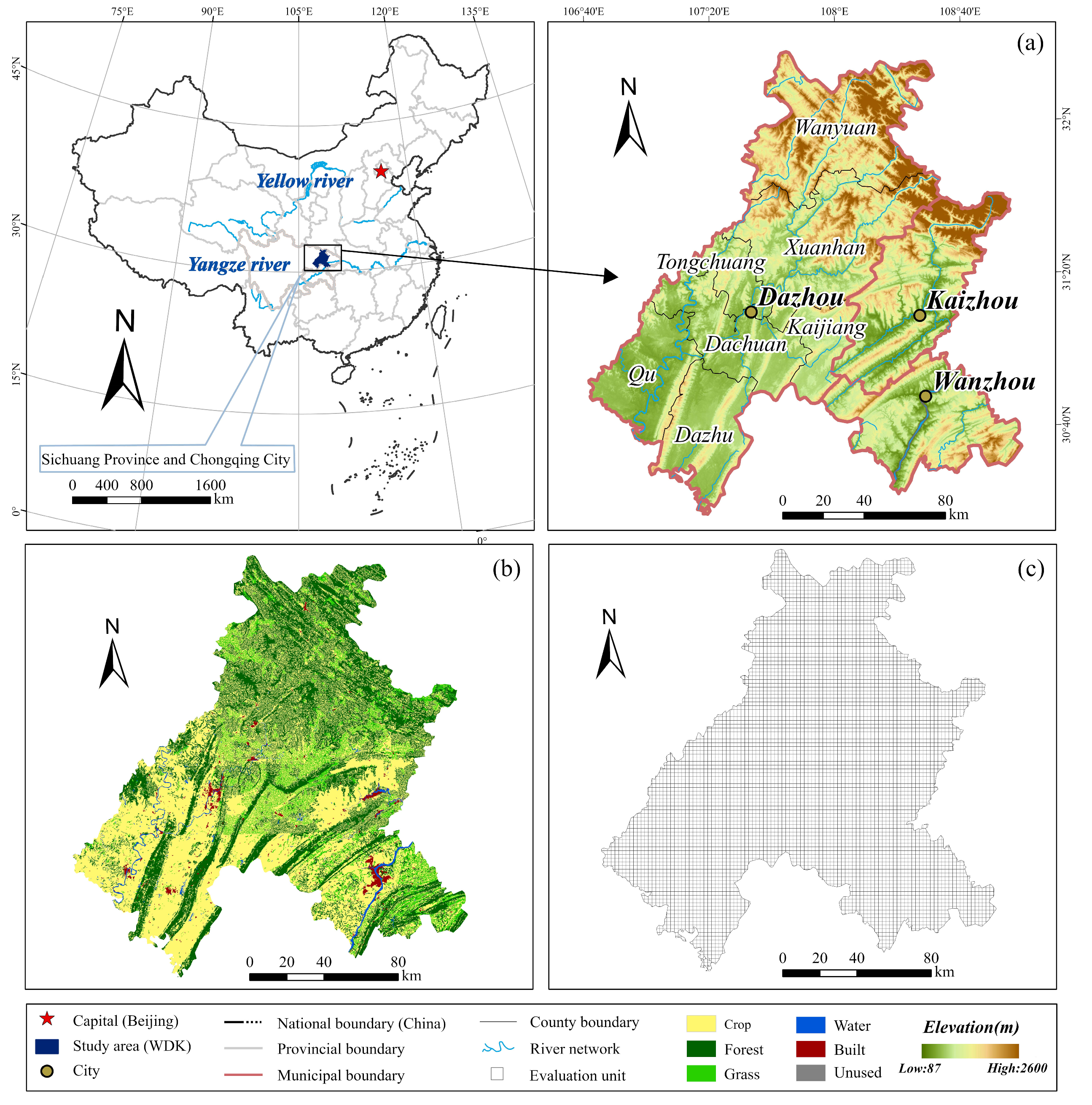





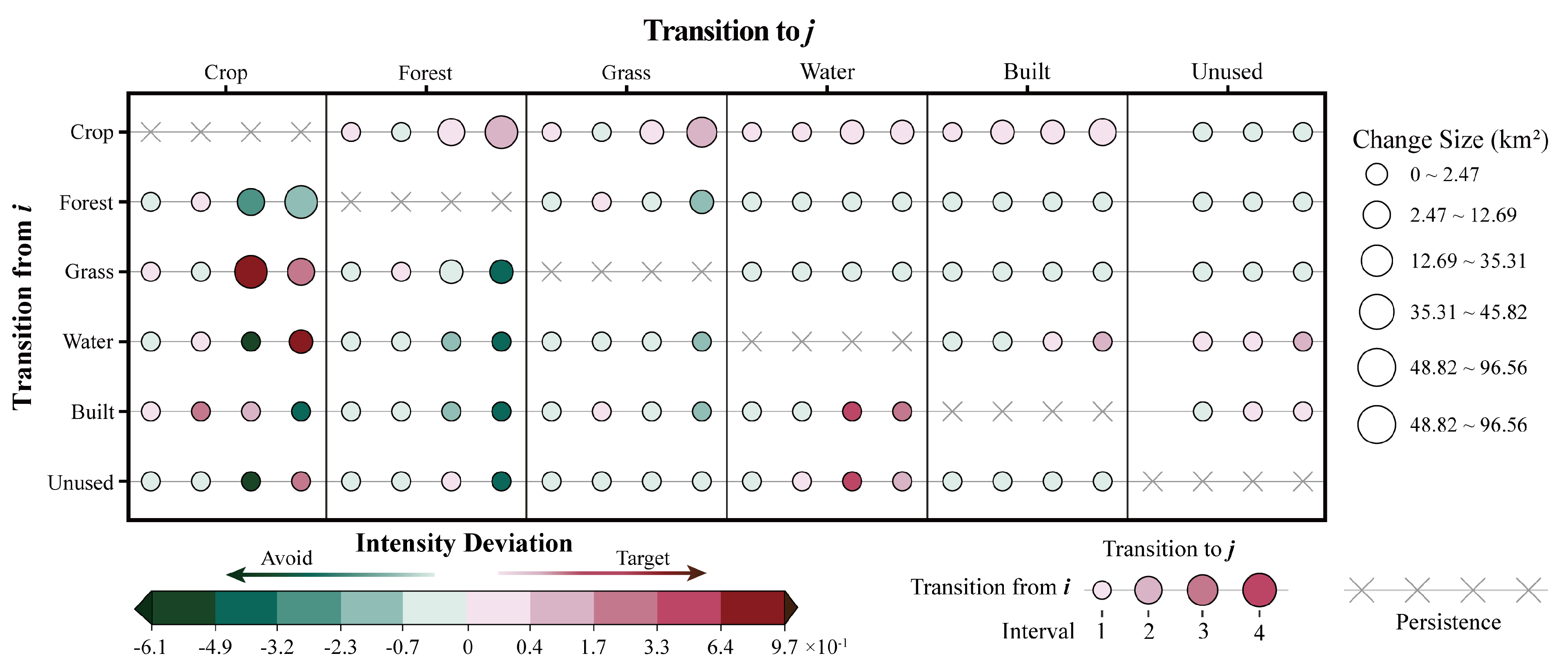
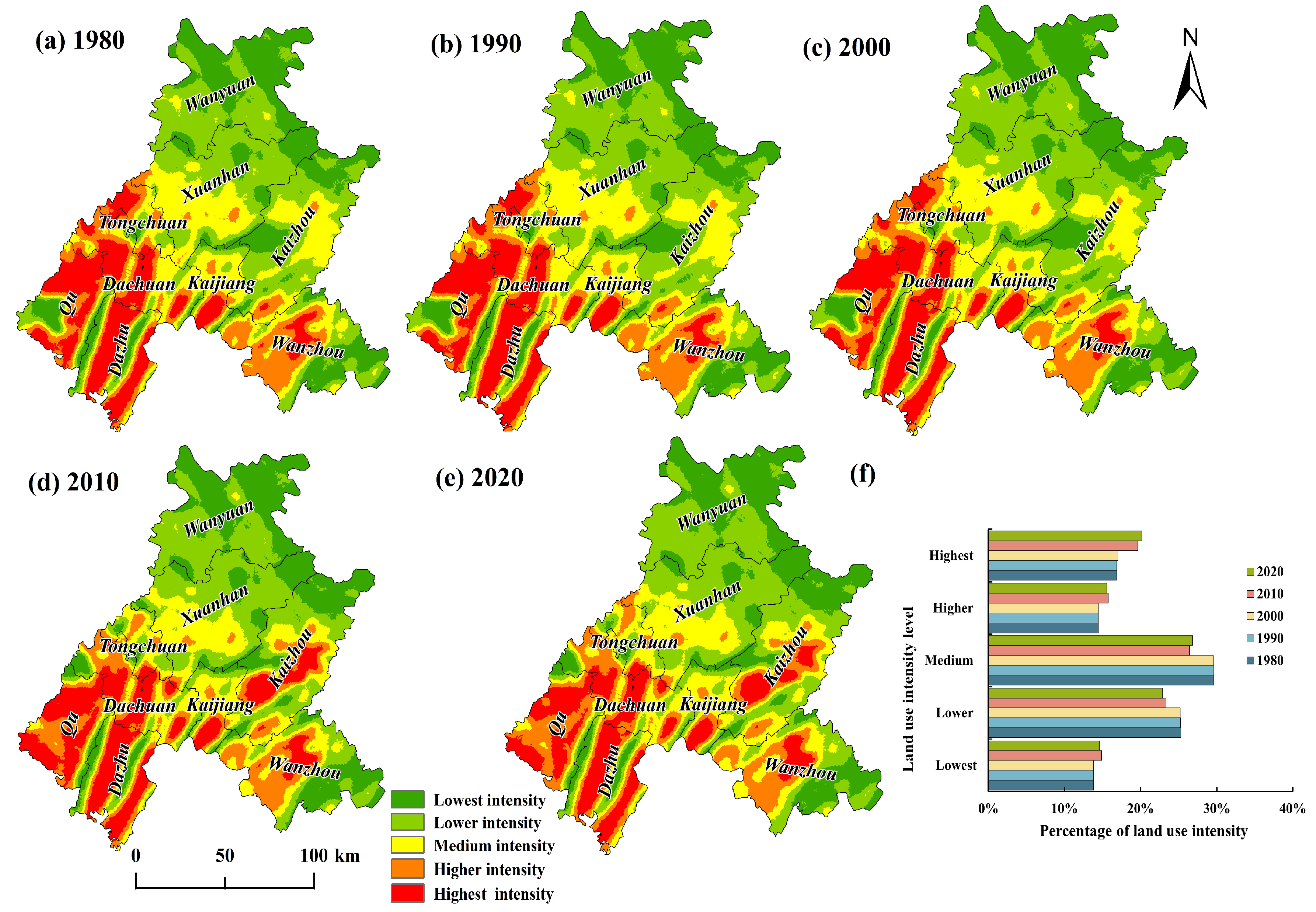

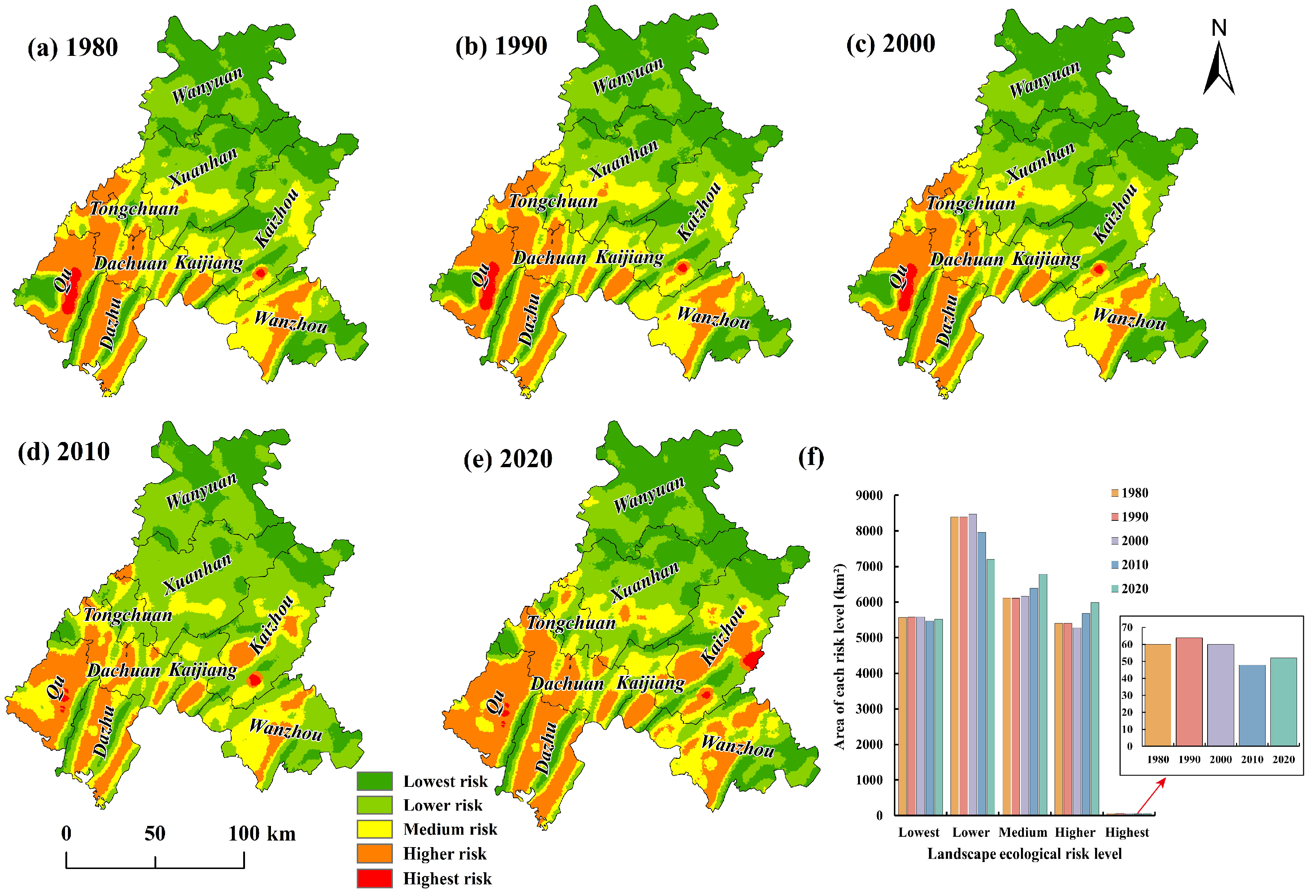
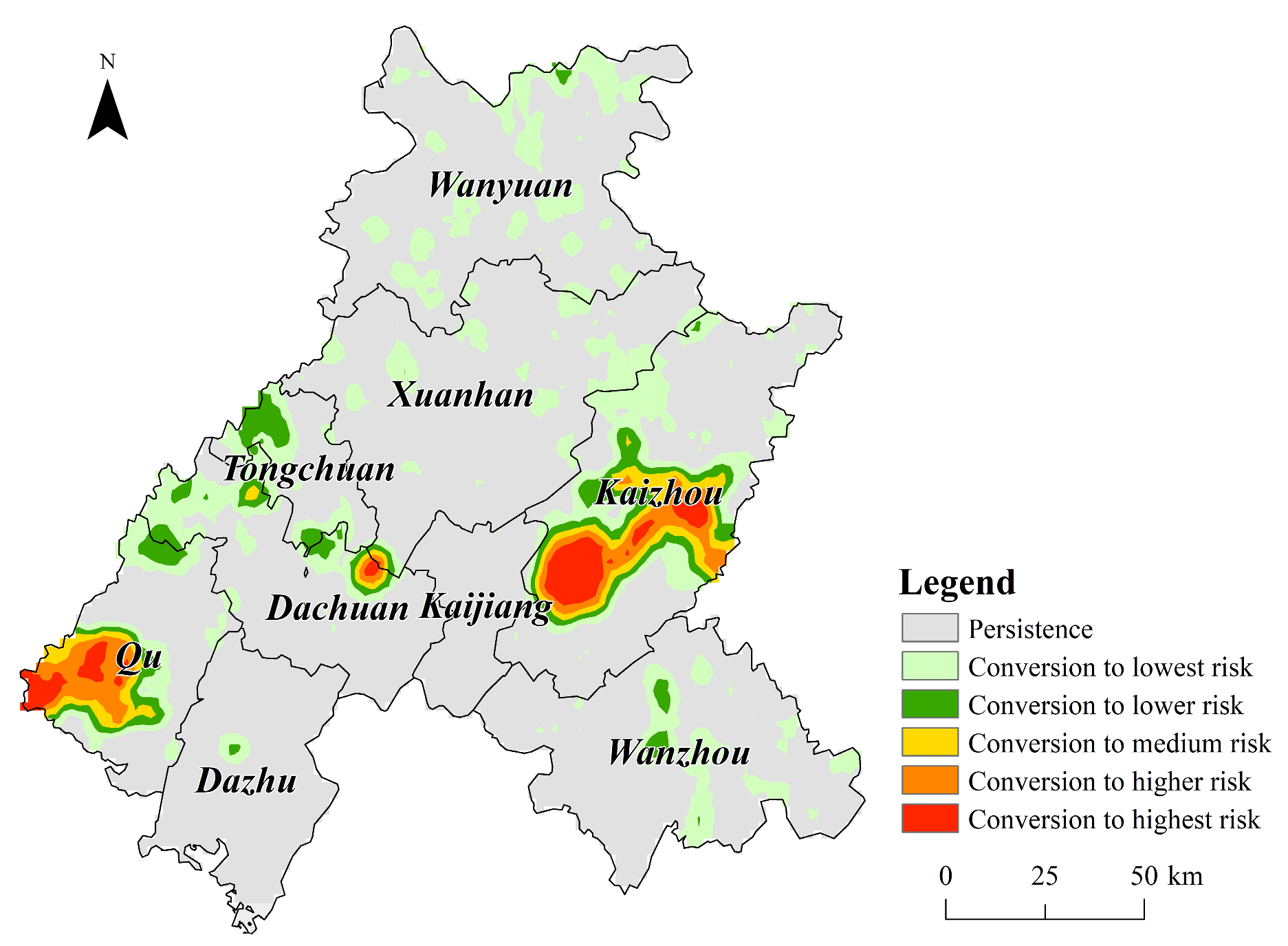
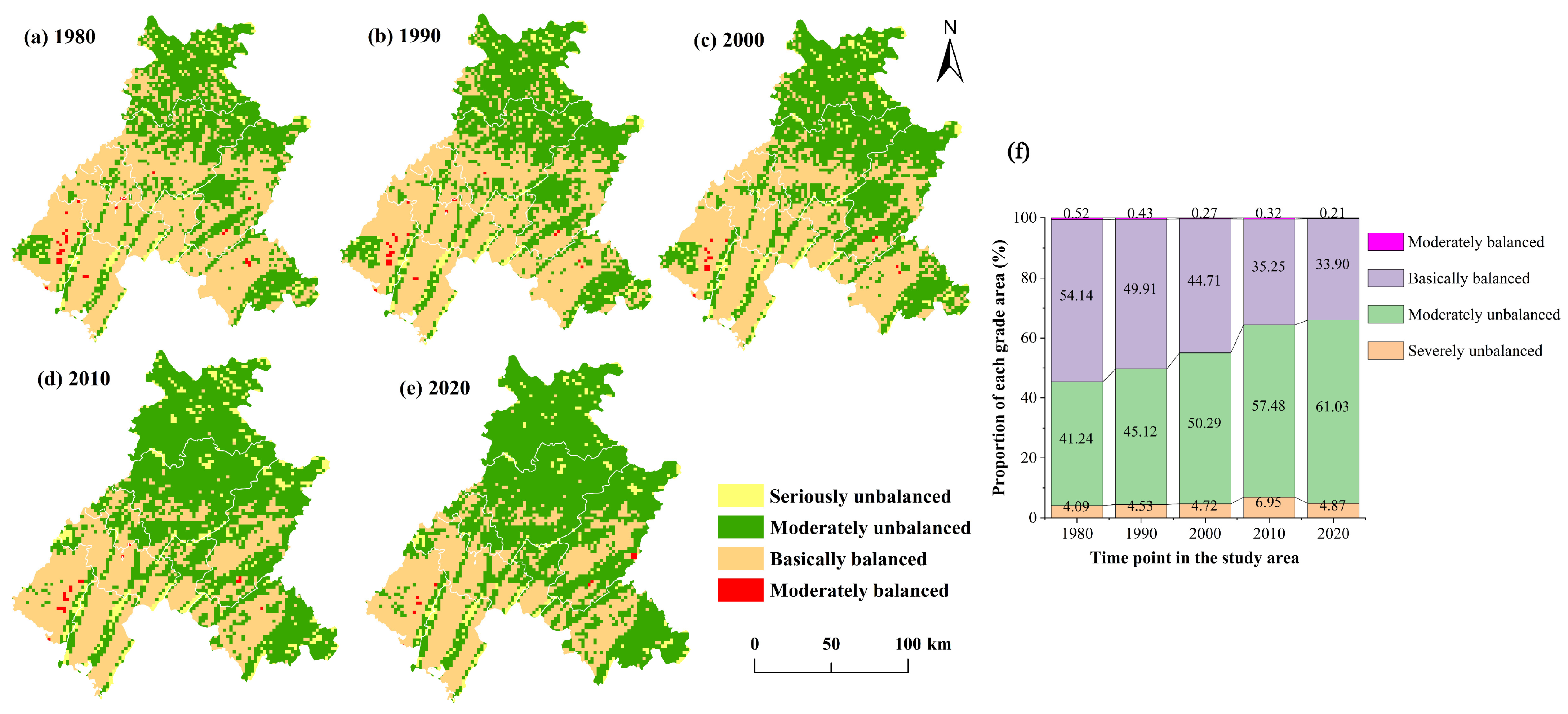




| Value | CCD Types |
|---|---|
| 0 < D ≤ 0.2 | Severely unbalanced |
| 0.2 < D ≤ 0.4 | Moderately unbalanced |
| 0.4 < D ≤ 0.6 | Basically balanced |
| 0.6 < D ≤ 0.8 | Moderately balanced |
| 0.8 < D ≤ 1 | Highly balanced |
| Extent (km) | Nugget Variance (Co) | Sill (Co + C) | Co/Co + C | R2 | RSS | Model |
|---|---|---|---|---|---|---|
| 1 | 2.569 | 9.400 | 0.727 | 0.983 | 2.74 × 100 | Gaussian |
| 2 | 0.676 | 3.385 | 0.800 | 0.995 | 5.17 × 10−2 | Gaussian |
| 3 | 0.314 | 1.416 | 0.778 | 0.955 | 8.94 × 10−2 | Gaussian |
| 4 | 0.211 | 1.310 | 0.839 | 0.920 | 7.31 × 10−2 | Gaussian |
| 5 | 0.198 | 1.548 | 0.872 | 0.872 | 5.78 × 10−3 | Gaussian |
| 6 | 0.168 | 1.234 | 0.864 | 0.888 | 8.25 × 10−3 | Gaussian |
| 7 | 0.153 | 1.231 | 0.876 | 0.877 | 7.67 × 10−3 | Gaussian |
| 8 | 0.136 | 1.899 | 0.928 | 0.895 | 8.26 × 10−3 | Gaussian |
| Extent (km) | Nugget Variance (Co) | Sill (Co + C) | Co/Co + C | R2 | RSS | Model |
|---|---|---|---|---|---|---|
| 1 | 0.074 | 0.255 | 0.710 | 0.714 | 7.80 × 10−3 | Gaussian |
| 2 | 0.061 | 0.361 | 0.831 | 0.961 | 5.96 × 10−3 | Gaussian |
| 3 | 0.062 | 0.479 | 0.870 | 0.921 | 2.35 × 10−3 | Gaussian |
| 4 | 0.064 | 0.844 | 0.924 | 0.919 | 1.47 × 10−3 | Gaussian |
| 5 | 0.076 | 0.992 | 0.923 | 0.879 | 2.45 × 10−3 | Gaussian |
| 6 | 0.096 | 1.130 | 0.915 | 0.893 | 3.14 × 10−3 | Gaussian |
| 7 | 0.110 | 1.360 | 0.919 | 0.902 | 3.63 × 10−3 | Gaussian |
| 8 | 0.121 | 2.141 | 0.943 | 0.895 | 6.04 × 10−3 | Gaussian |
| Year | Comprehensive Coordination Index | Coupling Correlation Degree | Coupling Coordination Degree | Type |
|---|---|---|---|---|
| 1980 | 0.234 | 0.760 | 0.425 | basically balanced |
| 1990 | 0.216 | 0.784 | 0.395 | moderately unbalanced |
| 2000 | 0.196 | 0.812 | 0.384 | moderately unbalanced |
| 2010 | 0.179 | 0.746 | 0.350 | moderately unbalanced |
| 2020 | 0.191 | 0.675 | 0.352 | moderately unbalanced |
Disclaimer/Publisher’s Note: The statements, opinions and data contained in all publications are solely those of the individual author(s) and contributor(s) and not of MDPI and/or the editor(s). MDPI and/or the editor(s) disclaim responsibility for any injury to people or property resulting from any ideas, methods, instructions or products referred to in the content. |
© 2025 by the authors. Licensee MDPI, Basel, Switzerland. This article is an open access article distributed under the terms and conditions of the Creative Commons Attribution (CC BY) license (https://creativecommons.org/licenses/by/4.0/).
Share and Cite
Zhan, D.; Quan, B.; Liao, J. The Spatiotemporal Evolution and Coupling Coordination of LUCC and Landscape Ecological Risk in Ecologically Vulnerable Areas: A Case Study of the Wanzhou–Dazhou–Kaizhou Region. Sustainability 2025, 17, 4399. https://doi.org/10.3390/su17104399
Zhan D, Quan B, Liao J. The Spatiotemporal Evolution and Coupling Coordination of LUCC and Landscape Ecological Risk in Ecologically Vulnerable Areas: A Case Study of the Wanzhou–Dazhou–Kaizhou Region. Sustainability. 2025; 17(10):4399. https://doi.org/10.3390/su17104399
Chicago/Turabian StyleZhan, Di, Bin Quan, and Jia Liao. 2025. "The Spatiotemporal Evolution and Coupling Coordination of LUCC and Landscape Ecological Risk in Ecologically Vulnerable Areas: A Case Study of the Wanzhou–Dazhou–Kaizhou Region" Sustainability 17, no. 10: 4399. https://doi.org/10.3390/su17104399
APA StyleZhan, D., Quan, B., & Liao, J. (2025). The Spatiotemporal Evolution and Coupling Coordination of LUCC and Landscape Ecological Risk in Ecologically Vulnerable Areas: A Case Study of the Wanzhou–Dazhou–Kaizhou Region. Sustainability, 17(10), 4399. https://doi.org/10.3390/su17104399







